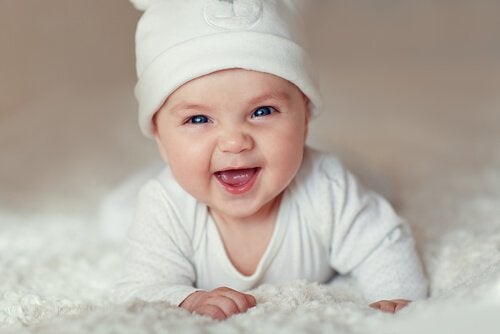Most of the gestures or sounds a newborn makes are considered “cute,” but one of them stands out: a baby’s smile. The sensations of seeing such a small being laugh have the power to awaken our most sentimental side, as well as having a powerful contagious effect.
But what does a baby mean when he smiles?Interestingly, depending on your age and the situation in which it occurs, you may be trying to convey something or something to us, it’s kind of like what happens with crying. a way, in the absence of words, to communicate their intentions and needs.
- Sometimes he cries to ask for food.
- Sometimes because he has gas or because he wants to change his diaper.
- Because of fever.
- Because of sleeping? Just as it is convenient to know the cause of crying.
- It is good to know what a baby’s smile means.
According to several studies, during the first weeks of life, smiling is a reflex act, it arises innately, unintended and automatic, because it is something for which people are genetically predestermined, the muscle in charge of drawing this gesture is the risorio only present in humans.
This means that the baby smiles without necessarily having fun, just listening to a nice sound, feeling a little tingling or seeing your mother’s face, in many cases a thoughtful look is enough to make you smile.
As the little one grows, the smile becomes a response to a specific stimulus, that is, it begins to have a trigger and appears as a means of expressing emotional nuances, let’s see what a baby’s smile looks like over the months.
Within two or three months of birth, the smile begins to be an expression of well-being, the baby smiles when he is satisfied and all his needs are met, it is the purest sign of harmony and happiness, so if your little one is smiling, you can rest quietly, because everything seems to be going well.
In addition, it is a flexible response because it can be shown in multiple circumstances, for example, after breastfeeding, when you find that your hunger is satisfied, also after a hot shower because it is clean and smells good, when you wake up in the morning, you have had a good night’s sleep or when your parents take you in their arms to play with you.
At 100 days and until about the sixth month, the so-called “conscious smile” appears, which is already selective. In other words, it is a response to an external stimulus that generates pleasure or recognition. This is a sign that you are getting used to a daily grooming routine.
A smile may appear in front of your mother’s voice, a song or a face that comes up to you and smiles at you, it should be noted that at this age the baby already knows how to distinguish a familiar face from another stranger, so he is not so friendly to strangers and only maintains a smile for family members.
Suppose the baby likes something and smiles, at this point if the adult returns the smile he will smile again, so gradually this gesture will become a sound and cheerful melody, the first action that usually provokes laughter in the baby It is the famous breath that occurs in the belly. Then, gestures or games in which the adult covers his face with his hands and then removes them quickly.
Just as this gesture appears unconsciously, it also appears at 4 months in the opposite way, at which point the little one learns to express himself by crying to express his discomfort.
After the first six months, babies can show different types of smiles depending on what they want to express: joy, pleasure, approval ?, as they grow, their perceptions and sensations become more accurate, so the variety of smiles is more accurate. another example of the emotional wealth it acquires. Thanks to this evolution, the laughter we enjoy so much is so contagious.
Gradually they discover how to make others laugh through vocalizations, babbling or gestures and using body language, thereby strengthening their social skills and starting to want to be protagonists and be part of various types of games.
At 12 months, a baby’s smile is enriched to the point that he already uses it voluntarily in response to predetermined stimuli, it is a completely social smile, because he uses it to express to others when something causes him joy, entertainment or surprise . knows when not to use it, feels fear, anguish or anger.
It is important that when the baby smiles, the adult responds in a pleasant and friendly way, with another smile, with affection, with a hug or playing with him, it is the best way to create that emotional bond and a healthy attachment. It’s also a way to teach the little boy that the figure in front of him is someone different from him.

